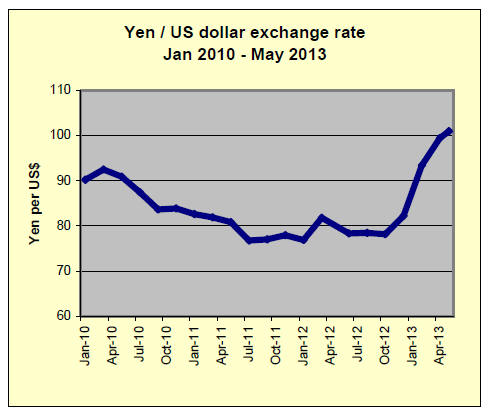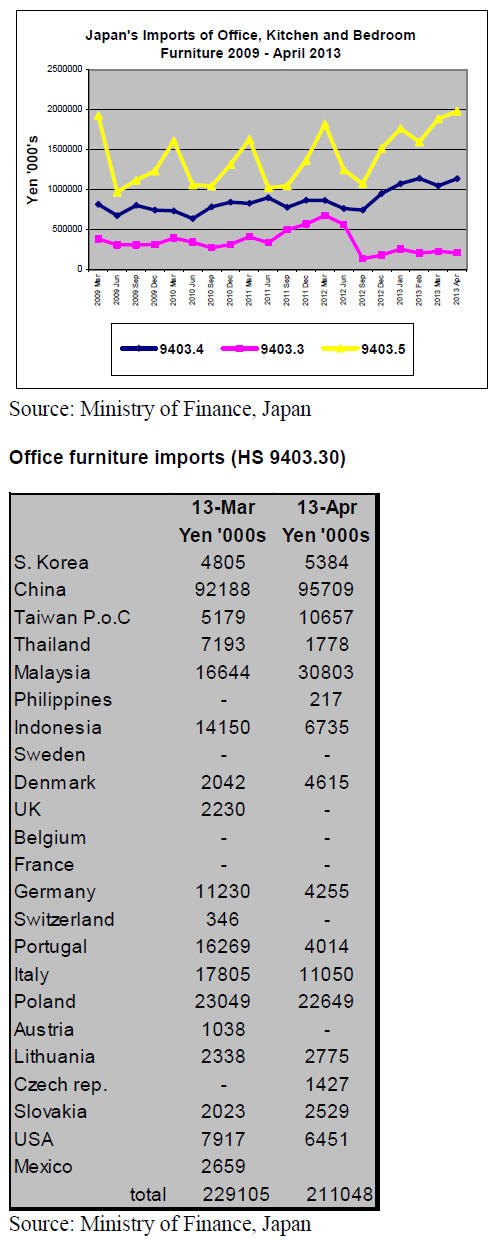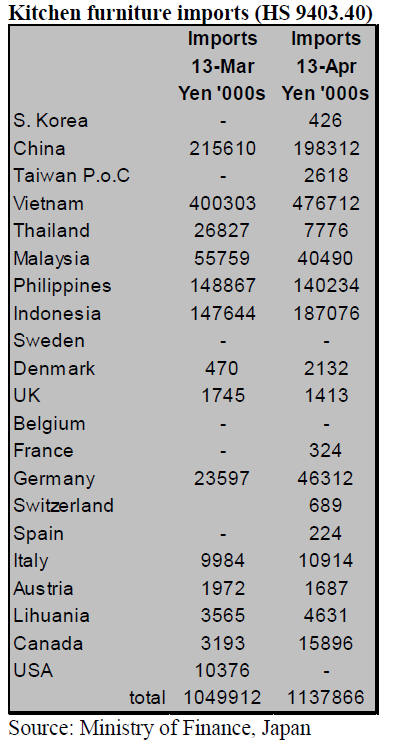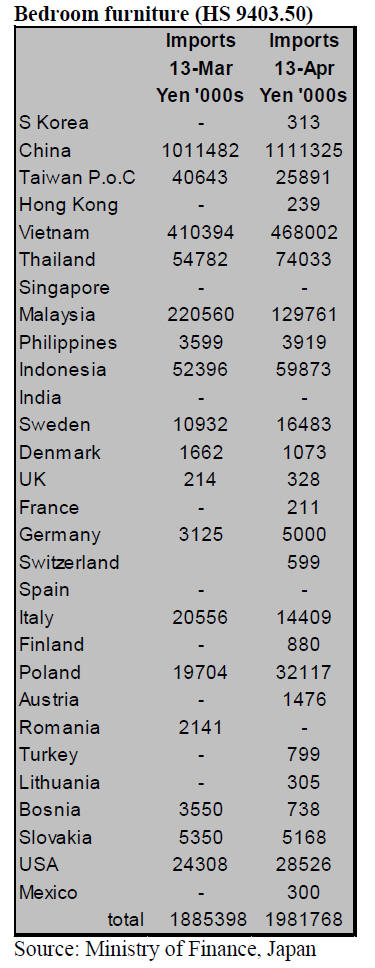Japan Wood Products
Prices
Dollar Exchange Rates of
26th May 2013
Japan Yen
101.31
Reports From Japan
First quarter GDP beats analyst’s expectations
Japan's economy grew at an annual rate of 3.5% in the first three months of
2013 according to the latest information from Japan's Cabinet Office.

On a quarterly basis GDP increased by 0.9% beating analysts expectations.
Consumer spending and exports were particularly strong. Private consumption
accounts around 60% of the economy.
The latest GDP data are seen as validating the government’s economy policies
and adding strength to the argument for a rise in consumption tax within a
year.
Market volatility a threat to ‘Abenomics’
Japanese shares fell sharply recently marking the steepest decline since
August 2011. The Topix (Tokyo Stock Price Index) lost 2.6% percent in a day
and the Nikkei 225 (another stock index in Japan) dropped just over 3%.
The immediate effect of the share sell-off was a strengthening of the yen
which gained around half a percent on the dollar.
Stock market volatility could undermine the campaign by the Japanese
government and Central Bank to lift the Japanese economy out of its decade
long state of deflation.
Analysts are saying that Japanese policy makers need to keep up the momentum
for change if there is to be a sustained growth following on after the
success in the first quarter of this year.
Japan’s Economy Minister was reported as saying the recent correction, while
faster than expected, does not mean there is a fundamental change in the
economic outlook.
The Bank of Japan has signaled it is in close communication with financial
markets around the world and will increase its efforts to present investors
with details of its long-term policy plans. The yen strengthened against all
major currencies in mid May.

Economic Outlook report highlights optimism among manufacturers
The Japanese government has upgraded its assessment of the economy and
according to the May Economic Outlook from the Cabinet Office there are
signs of an improvement in exports and industrial output which, says the
update, suggests the government’s aggressive monetary polices are having the
desired results.
The previous Economic Outlook in April said the economy was improving but
was still showing signs of weakness in some areas but the latest report is
more optimistic.
Increasing optimism among manufacturers was one positive sign says the
report as exporters in the electric and precision machinery sectors are
benefiting from the weak yen.
To temper the positive news the report notes that while there are positive
indications of an improvement in the economy, some companies are not as
optimistic as there has been little growth in ‘real’ demand which, they say,
could mean a sustained recovery is some way off.
The Cabinet Office says the economy will continue to recover as exports
improve and as economic stimulus and monetary policy continue to lift
sentiment.
See
http://www5.cao.go.jp/keizai3/getsurei-e/index-e.html
Trade news from the Japan Lumber Reports (JLR)
The Japan Lumber Reports (JLR), a subscription trade journal published every
two weeks in English, is generously allowing the ITTO Tropical Timber Market
Report to extract and reproduce news on the Japanese market.
The JLR requires that ITTO reproduces newsworthy text exactly as it appears
in their publication.
For the JLR report please see:
http://www.n-mokuzai.com/modules/general/index.php?id=7
Impact of depreciation of the yen
To stop long lasting deflation, the Abe regime and the Bank of Japan took
monetary easing policy, which depreciates yen’s exchange rate sharply in
short time.
The yen was 78 yen to the dollar in last fall then it plunged to 102 yen,
about 30% drop in six months. Also the yen depreciated to the Euro by about
25%.
Wood industry is facing inflation of imported wood materials by weakening
yen.
Not only wood products but cost of other materials like adhesive for plywood
and laminated lumber and fuel cost of transportation is climbing.
Housing market this year looks positive with coming hike of consumption tax
and recovery of general economy as stock market is booming and corporate
revenue is increasing particularly on export business but transferring of
rising cost of materials is not fast enough as speed of depreciation is too
fast.
The prices of European structural laminated lumber have been fixed the yen
for the second quarter. Whitewood laminated post prices are 2,050 yen per
piece delivered and redwood laminated beam prices are 62,000 yen per cbm so
that there is no influence of exchange rate on those items until summer but
the focus is climbing cost of European lamina, which pushes manufacturing
cost of laminated lumber by domestic laminated lumber mills.
Prices of Canadian SPF dimension lumber (2x4-8) for the second quarter are
about $610 per MBM C&F, 37% higher than the same quarter last year. With
exchange rate of 102 yen, it would coat about 46,000 yen while current
market prices are about 45,000 yen per cbm FOB truck port yard.
Second quarter prices of Douglas fir baby square are about US$510 per cbm
C&F, which costs about 52,000 yen then May prices are about US$550. With
exchange rate of 102 yen, the cost would be over 60,000 yen. Current
wholesale prices have gone up to 57,000 yen but further hike is necessary.
If the prices go up over 60,000 yen, there will be competition with domestic
cypress square.
South Sea imported plywood export prices are about US$550 per cbm C&F on JAS
concrete forming panel. This costs about 1,220 yen per sheet but the market
prices are
1,130-1,150 yen so another 100 yen price increase is necessary. Since log
supply shortage in South East Asian countries is critical, export prices
seem to go up more.
Domestic softwood plywood manufacturers’ cost depends on how much imported
materials mills use. Domestic cedar is becoming the main materials but some
mills still use North American Douglas fir and Russian larch logs, which
cost is higher by weak yen.
South Sea (tropical) log prices continue climbing
According to Sarawak Timber Association, log production in January and
February was 16% less than the same months a year earlier. Current FOB
export prices are $300 on meranti regular, $250 on meranti small and
$230-235 on super small.
Market log prices in Japan are about 9,400 yen per koku on meranti regular
but June and July arrivals would cost about 10,700 yen, 14% higher than
current prices and 40% higher than the prices in last fall.
North American log export prices have been escalating by active housing
starts in the U.S.A. so that the lumber prices in Japan have been going
up.Chugoku Lumber, the
largest Douglas fir lumber manufacturer has raised the prices three times
successively since last February but increase of export log prices and
depreciation of the yen continue so that it has to increase the prices
further.
With busy demand, buyers have to accept higher prices. Prices of DF dry beam
have gone up to 54,000 yen per cbm delivered and of green beam to 42,000
yen.
Orders for dry beam Chugoku Lumber makes are brisk so that it has no extra
production of high demanded baby squares.
Russian lumber prices were high even without exchange rate of weak yen. The
suppliers’ prices have been climbing by log shortage.
Russian made red pine taruki (30x40 mm) prices shot up to 63,000 yen per cbm
FOB truck port yard and domestic mills’ product prices are 68,000 yen
delivered. They are about 10,000 yen higher compared to beginning of the
year.
March plywood supply
Total supply of plywood in March was 549,300 cbms, 15.6% more than March
last year and 10.0% more than February.
Total imported plywood arrivals in March were 317,900 cbms, 19.3% more and
11.9% more.Volume from Malaysia was 153,000 cbms, 53.0% more and 11.7% more.
That from Indonesia was 96,200 cbms, 5.5% more and 19.8% more.
Average monthly arrivals of imported plywood in last twelve months were
297,500 cbms so March arrivals exceeded average monthly volume.
In March, shipments by the largest Malaysian supplier increased and
unloading at port of Yokohama delayed and several thousand cbms are carried
over into April so that
April arrivals would be over 300 M cbms. Then after April, import volume is
estimated to drop sharply because of log shortage in producing regions and
purchase curtailment by Japan.
Domestic plywood production in March was 231,400 cbms, 10.9% more and 7.6%
more, out of which softwood plywood was 216,400 cbms, 14.1% more and 9.7%
more. This is the largest monthly production since June 2007.
Shipment of softwood plywood was 218,900 cbms, 35.0% more and 6.8% more.
This is six consecutive months that the shipment exceeded 200 M cbms. The
inventories were 125,100 cbms, about 2,500 cbms less than a month ago.
South Sea (tropical) log supply
Weather in Sarawak, Malaysia is improving but imbalance of log supply
and demand remains. Log supply should recover shortly but the demand is
brisk. India is active in log purchase since late March so that export log
prices continue climbing.
Sarawak meranti regular log supply is tight and FOB prices are as high as
US$300-305 per cbm on yellow meranti. Small meranti prices are over US$250
and super small are about US$230. They are all firm and strong.
Meanwhile, purchase by Japan is slow. Plywood mills in Japan try to avoid
high log prices by skipping regular purchases. Or they are seeking other
sources to buy logs if the prices continue going up. The importers have
trouble because the suppliers’ prices and Japanese buyers’ idea prices are
too far apart.
Weather in PNG is still in rainy season and heavy rain falls hamper log
production. Meantime, China continues aggressively purchasing logs in PNG
and many log ships for China are tied up in ports, waiting for logs.
There are busy inquiries in Sabah to replace Sarawak logs and some plywood
mill is preparing to buy serayah logs in Sabah, which is often short in
scale measurement.
Log prices in Japan are firming because of weak yen. Price negotiations
between log importers and plywood mills are tough going.
Meranti regular log prices are 9,400 yen per koku CIF, 500 yen up from
April. Plywood mills suffer high log and adhesive cost and beg customers to
accept higher plywood prices.
Price trends for imported Indonesian and Malaysian plywood

Japan’s April furniture imports
The source and value of Japan’s office, kitchen and bedroom furniture
imports for April 2013 are shown below. Also illustrated is the trend in
imports of office furniture (HS 9403.30), kitchen furniture (HS 9403.40) and
bedroom furniture (HS 9403.50) between 2009 and April 2013.

In April 2013 Japan’s imports of office furniture from China and Malaysia
accounted for more than half of total imports of this category of furniture.
If imports from Poland are added to those from China and Malaysia then three
countries account for 71% of office furniture imports.
Apirl imports from China were at around the same level as in March but
imports from Malaysia jumped from yen 16,6mil. to yen 30.8 mil. Imports from
EU member states accounted for just 25% of Japan’s office furniture imports
in April. The main EU suppliers were Poland at yen 22 mil. followed by Italy
at yen 11mil.. Office furniture imports from the EU all declined in April.
In April, Japan’s total office furniture imports totaled yen 211 mil a
decline of 7.8% from March mainly because of the drop in imports from the EU
Kitchen furniture imports (HS 9403.40)
Kitchen furniture imports remain the second largest segment of all wooden
furniture imports into Japan after bedroom furniture.

Vietnam continues to be the number one supplier of kitchen furniture to
Japan. In April the value of imports from Vietnam totaled yen 476 mil. up
around 20% from levels in March this year representing alost 42% of all
kitchen furniture imports.
Three suppliers Vietnam, China and Indonesia accounted for 75% of total
kitchen furniture imports by Japan in April and if shipments from the
Philippines is included, then four suppliers provided 88% of the total
Shipments of kitchen furniture from Europe in April were dominated by those
from Germany, yen 46 mil. almost double the value of March shipments. Italy
was the second largest supplier in Europe at yen 10 mil. a figure close to
that for March shipments.
Canada feature as supplier of kitchen furniture to Japan in April and the
value of shipments at almost yen 16 mil. were around three times the level
in March this year.
Bedroom furniture (HS 9403.50)
Japan’s imports of bedroom furniture are close to yen 2 bil. monthly.
Imports in April were valued at yen 1.98 bil. up from the yen 1.88 bil. in
March this year.

As in March the top suppliers were China and Vietnam which together
accounted for around 79% of all wooden bedroom furniture imports to Japan.
Shipments of bedroom furniture to Japan from China in April were up over 9%
and shipments from Vietnam, the second largest supplier, were up 12%.
The performance of exporters in SE Asia was mixed in April with Malaysia
shipping yen 13 mil. down a massive 45% while companies in Indonesia shipped
13% bedroom furniture in April (yen 59.8 mil.) compared to levels in March.
|